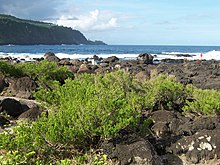bio.wikisort.org - Plant
Pemphis acidula, commonly known as bantigue (pron. bahn-TEE-geh) or mentigi,[2][3] is a species of flowering plant in the family Lythraceae. It is a mangrove found throughout most of the tropical Indo-Pacific growing on rocky shores. The genus Pemphis, to which it belongs, was until recently thought to have only this single species, first described in 1775 and long considered the type species,[4] but is now believed to have at least one other.[5]
| Pemphis acidula | |
|---|---|
 | |
| Pemphis acidula bushes on the shore of Réunion Island | |
Conservation status | |
| Scientific classification | |
| Kingdom: | Plantae |
| Clade: | Tracheophytes |
| Clade: | Angiosperms |
| Clade: | Eudicots |
| Clade: | Rosids |
| Order: | Myrtales |
| Family: | Lythraceae |
| Genus: | Pemphis |
| Species: | P. acidula |
| Binomial name | |
| Pemphis acidula J.R.Forst & G.Forst | |
| Synonyms | |
Distribution and habitat
Pemphis acidula is a halophyte bush found in coastal locations in the tropical areas of the Indo-Pacific. It is one of the types of shrubs growing in sandy and calcareous soils of the littoral zones of the Indian Ocean and the western and central Pacific Ocean. It is also found in mangroves.[6]
Uses
The wood of this species has been traditionally valued in many cultures for it is hard and heavy, as well as resistant to rot and warping. It also has naturally a fine finish and may be fashioned into walking canes, fence posts, tool handles, and even anchors.[7] In Réunion and Mauritius it is known as bois matelot[8] In the Maldives this hardy wood was used in traditional shipbuilding to hold the planks of the hull together, as well as to fashion "nails" in local sorcery.[9]
Pemphis acidula is also one of the plant species used in bonsai. Due to its tropical preference and typhoon-resistance, it is the most common species for bonsai in the Philippines; but it is also grown as bonsai in Taiwan and the Ryukyu Islands of Japan.[2][10][11] Due to its popularity and high value among bonsai enthusiasts, it is among the list of species classified as 'threatened' by the Department of Environment and Natural Resources of the Philippines. The collection, selling, and transport of wild Pemphis acidula is illegal in the Philippines and punishable by fines and imprisonment of up to six years.[12][13]
In Marovo Island, Tonga, Tahiti, and other South Pacific islands, it is used to make wooden tools such as pestles, tool handles, weapons, and combs.[14]
In Taiwan's Kenting National Park illegal picking has had a negative impact on the coastal ecosystem.[15]
Leaves, flowers and fruits
 |
 |
 |
See also
- Mangroves
References
- IUCN Red List of Threatened Species
- Enriquez, Marge C. "The Philippine 'bantigue' still rules the bonsai scene". Lifestyle.Inq. Philippine Daily Inquirer. Retrieved 13 September 2020.
- "Mentigi". Wild Fact Sheets. Wild Singapore. Retrieved 13 September 2020.
- Char. Gen. Pl. 34. 1775 "Plant Name Details for Pemphis acidula". IPNI. Retrieved November 21, 2009.
- "TPL, treatment of Pemphis". The Plant List; Version 1. (published on the internet). Royal Botanic Gardens, Kew and Missouri Botanical Garden. 2010. Retrieved 26 August 2013.
- Piggott, C.J. (1961). "Notes on Some of the Seychelles Islands, Indian Ocean" (PDF). Atoll Research Bulletin. 83: 1–10. doi:10.5479/si.00775630.83.1. Archived from the original (PDF) on 2006-09-13.
- Wim Giesen; Stephan Wulffraat; Max Zieren; Liesbeth Scholten (2006). "Part 2: Description - Trees & shrubs". Mangrove Guidebook for Southeast Asia. Bangkok, Thailand: FAO, Regional Office for Asia and the Pacific; Wetlands International. ISBN 974-7946-85-8. Retrieved November 21, 2009.
- xycol.net Pemphis acidula J.R. Forst., 1775 - Nom pilote : miki miki
- Xavier Romero-Frias, The Maldive Islanders, A Study of the Popular Culture of an Ancient Ocean Kingdom. NEI (1999), ISBN 84-7254-801-5
- Cheng Cheng-Kung (2007). "Pemphis acidula — A Tropical Classic" (PDF). Bonsai Societies of Florida Magazine. Cooper City, Florida: Bonsai Societies of Florida (BSF). XXXVIII, No. 4 (152 (Winter edition)).
- Yap, Julio. "Proper maintenance and care for bonsai". Agriculture Monthly. Retrieved 13 September 2020.
- "P300T worth of threatened PH plant seized". Panay News. Retrieved 13 September 2020.
- "DENR seizes P300K worth of threatened plant species". Department of Environment and Natural Resources. Republic of the Philippines. Retrieved 13 September 2020.
- Pawley, Andrew; Osmond, Meredith (eds). 2008. The lexicon of Proto Oceanic: The culture and environment of ancestral Oceanic society. Volume 3: Plants Archived 2019-02-04 at the Wayback Machine. Pacific Linguistics 599. Canberra: Pacific Linguistics, Australian National University.
- Tzu-hsuan, Liu. "Illegal picking of reef pemphis raises concern in Kenting". taipeitimes.com. Taipei Times. Retrieved 30 April 2022.
External links
 Media related to Pemphis acidula at Wikimedia Commons
Media related to Pemphis acidula at Wikimedia Commons
Другой контент может иметь иную лицензию. Перед использованием материалов сайта WikiSort.org внимательно изучите правила лицензирования конкретных элементов наполнения сайта.
WikiSort.org - проект по пересортировке и дополнению контента Википедии
